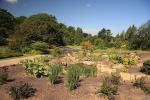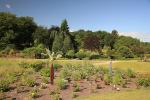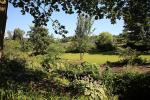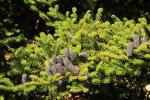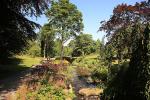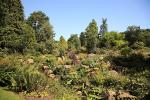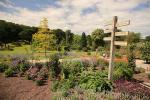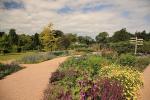Friday 16th July 2021
I had booked tickets a couple of weeks ago to visit the gardens again at Harrogate, not realising at the time that our visit would coincide with the last day of Yorkshire Show also in Harrogate. In the end it didn’t make a great deal of difference. I have to drive past the Harrogate showground to get to the gardens at Harlow Carr, consequently the volume of traffic in that area was considerably higher than usual which in turn results in delays etc. As it turned out the traffic flow system into the Yorkshire show ground was well organised and controlled and after a slight delay, we actually had a trouble-free journey arriving at the gardens on the other side of Harrogate just 10 minutes later than planned.
It was a warm and humid morning 15C, the sun broke through the low mist around 10.45am just after we arrived which made for a very pleasant walk, not too warm, but good short sleeve shirt weather, no jacket.
I popped into Betty’s café for a takeaway coffee before heading through the booking office and into the gardens. We did our usual clockwise walk today, from the visitor’s centre headed down the slope and turned left admiring the colourful borders in front of the restaurant. A little further on, heading towards the Bramall Learning Centre, we passed our first sculpture. The sculptures are part of an exhibition entitled ‘The Four Seasons’ by the American artist/designer Philip Haas and this was one of four located around the gardens, you cannot really miss them standing some four and a half metres in height. Each of the statues is reminiscent of the seasons, depicting the flowers, ivy, moss, fungi, fungi, fruit, vegetables abundant for that particular season. They reflect the constantly changing cycle of nature here at Harlow Carr. Cathy Killick one of our local BBC ‘Look North’ news reporter was there with a cameraman doing several pieces to camera which were aired later that evening on the television. We continued our walk, passing the Learning centre and library on the left and the ‘Teaching Gardens’ and ‘Lakeside Gardens’ before we reached the sunken ‘Edwardian Garden’. I’ve read that this section of the garden was originally created for the BBC television series ‘Gardens through Time’ and this Edwardian Garden represents the garden philosophy at the turn of the 20th century. The paving area and dry-stone walls still looks fresh, clean and new having been refreshed and refurbished a couple of years ago.
We continued our walk passing through the ‘John Brookes Garden’ which reflects the garden philosophy of the 1960’s, this area looks to be in the process of re development including the installation of a bridge across the corner of the QM lake, which will be nice to look forward too. Passing Diarmuid Gavin Garden on the right, it was back in 2004 when this garden was designed with a contemporary theme using modern materials to create a low maintenance space. It still looks good although not my type of garden style.
Continuing down and around the QM pond we stopped to watch some tiny Coot chicks swimming amongst the weed at the water’s edge and dragonflies flitting from one Iris to another, the stream flows from the QM pond and runs east to west throughout the garden, it cleverly knits together the formal gardens and borders to the woodland slopes on the other side of the stream. The paths within Streamside echo the meandering route of the stream, this area is home to a wide range of wildlife, including dippers, tree creepers, weasels, and voles.
Much of the planting along both sides of the stream was laid out by Geoffrey Smith an early custodian of the garden and regular television gardening expert, sadly now passed away. No matter what time of year you visit the gardens the streamside is awash with colour and a vast array of plants which thrive in those conditions. Moisture-loving planting includes hostas, Rodgersia, Gunnera, Astilbe, Filipendula and Iris sibirica, as well as ferns from the National Plant Collection of Dryopteris all thrive in these surroundings especially the Hosta ‘Empress Wu’, one of the world’s largest hostas with leaves up to 56cm (22in) across, they are massive.
As I have previously mentioned on earlier visits, several of the stone bridges across the stream have been either rebuilt or refurbished over the past couple of years and the banks planted with beautiful, bright and vibrant Primulas, they certainly look colourful and a constant source of pollen for the Bees.
Considerable work was done in 2020 during the Covid lockdown period when the garden were closed to the public, the sandstone garden was re designed and established with huge boulders and fine planting, all designed to protect the stream from floodwater erosion.
We reached the old Bath house at the end of the streamside walk a few minutes later, where we had a browse around the arts and craft exhibition that was currently being held there. The old Bath house dates back to the 19th century and was built to enable guests at that time to enjoy the ‘spa water’s. The stone building originally contained 12 cubicles in which people would bathe in heated sulphur water. The wellheads which provided the water have since been capped, but on a calm day you can occasionally get a whiff of sulphur.
After a sit down and coffee at Bettys outdoor café, we continued our walk up the gentle slope to the kitchen gardens, the raised beds were full of varieties of vegetables which thrive on the heavy clay soil. We stopped to admire the 2nd of the huge sculptures adjacent to the Garden centre before heading back along the formal gardens, the borders are awash with colour and plants of all shape, colour and form. I always like to head back down to the stream and walk along the otherside of the stream for a few moments before heading up through the newly restored Sandstone Garden, this is a lovely area with the ponds, new path and refreshing planting a lovely place to sit and contemplate for a few moments. From here it is just a short walk back to the visitor’s centre and Bettys main café, alas the wait for a table was over on hour so we popped into the shop for a couple of sandwiches and buns to take home with us. As always, a lovely walk in very pleasant surroundings. Now where were those other two sculptures?
|



